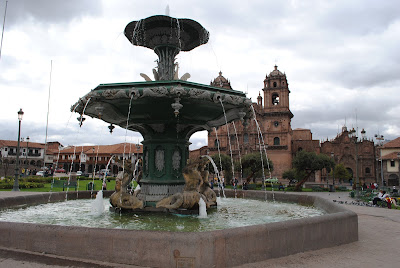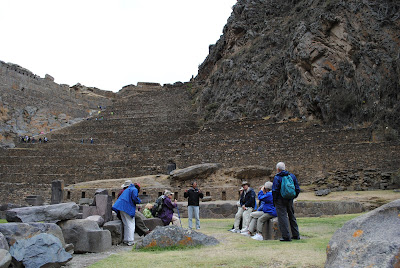Ollantaytambo
Day 1: Lima
Depart U.S./Arrivals in Lima, Peru
Arrivals at the Jorge Chávez International Airport in Lima.
Over night in Lima
Day 2: Sacred Valley
Flight to Cusco and Coach to the Sacred Valley/Field trip to Ollantaytambo Ruins
Arrive in Cusco and transfer by coach to the Sacred Valley with a visit to Ollantaytambo ruins.
Ollantaytambo is a town with original buildings of Inca construction where the
Inca retreated to make their last stand in the highlands against the Spanish.
Running water still flows through the town in aqueducts and the terraces above the
town still are farmed.
Day 3: Sacred Valley - Moray Inca Ruins/Salinas Salt Pans
Trip to Moray, an ancient site of large circular terraces built
by the Inca as an outdoor agricultural research station.
As you walk around the terraces they decrease in size to a central point making this hike a wonderful opportunity to acclimate in preparation for the Inca Trail.
Then there is an excursion to the Salt Pans of Salinas for a brief demonstration
of the salt extraction process.
Walk down to the Urubamba River and the small town of Salinas for a visit.
Day 4: Sacred Valley - Pisac Market
Depart in the morning for the town of Pisac.
Enjoy an incredible acclimatizing walk through the Pisac ruins and then down to the town.
Return to the hotel for some free time before dinner.
After dinner your leader will conduct a final briefing session on the Inca Trail in preparation for the big hike.
15
Day 5: Inca Trail - Hike to Patallaqta Ruins and Huayllabamba
After Breakfast at the hotel restaurant, depart for Ollantaytambo, KM82, where we will meet our porters and have a final pit stop.
We hike to the official control point to the start of the Inca Trail.
***Original, valid passports must be ready to be presented to the officials.
We then cross a footbridge over the Urubamba River and start your hike!
After an hour and a half or so you arrive at the Patallaqta viewpoint. These classic Inca ruins at the intersection of three valleys with wonderful photo opportunities.
Consult your group leader if you feel unwell and are apprehensive about the Inca Trail hikes.
Option #1:Take part in the first day of the hike and see how you feel.
If you decide not to continue, provisions will be made to transfer you to Cusco.
However, if you continue, you will need to complete the hikes all the way through to Machu Picchu.
Option #2: If you decide not to attempt any hikes, provisions will be made to transfer you back to Cusco. **Note: going back to Cusco will be at your own expense**
Day 6: Inca Trail - Huayllabamba to Pacaymayo
Early morning wake-up call with a hot beverage and breakfast at the camp.
The first portion of your hike this morning will take approximately 1:30 minutes.
The first stop will be at Ayapata for the opportunity to rest, use the local toilet
facilities, and/or rehydrate.
Continue walking on ascending stairs for 2:30 minutes.
Lunch at Llulluchapampa in the valley.
After lunch, begin your 2 hour walk to Abra Warmiwañuska at an elevation of approximately 13,776 ft. This is the toughest and highest pass of the trek!
Descend to the second campsite at Pacaymayo at 11,580 ft for tea time and relaxation.
Day 7: Inca Trail - Pacaymayo to Phuyupatamarka
Again the porters will greet you tent side with an early morning wake-up call with a hot beverage.
Breakfast at camp before you begin the approximately 1 hour hike to the Runkuracay archaeological site overlooking the Pacaymayo Valley.
After an exploration of the site, you will hike to the Runkurakay Pass, 12,960 ft, the second pass on the trail. After reaching the pass, continue downhill for approximately 1 hour before arriving at the narrow staircase that will take you into Sayacmarca, "Inaccessible Town".
The ruins of Sayacmarca are the remnants of a fortress or travelers' lodge used by
the Inca. Sayacmarca was built on a narrow mountain ridge with only one
entrance, probably planned as a means of defense. The thatched roofs are long
gone, but an observatory, small plaza, ritual baths, housing complex, and other
constructions remain. The lack of agricultural terraces and farmland point to a
dependence on outside suppliers.
In its heyday, Sayacmarca is thought to have housed as many as 200 people.
Leave the ruins and hike for another 20 minutes before breaking for lunch.
Lunch stop at Chaquicocha.
Then after lunch, continue walking for another 1:45 minutes to the last campsite at Phuyupatamarka, 10,695 ft. Once at the camp, reward your day's efforts with a tea break and free time before dinner.
Day 8: Machu Picchu - Phuyupatamarka, Wiñay Wayna & Intipunku Ruins
Your final early wake-up call to witness the spectacular sunrise from the viewing platform at Phuyupatamarka. Hot beverages will be provided before your final breakfast at camp is served.
Later that morning, begin walking to the archaeological ruins, located approximately
15 minutes from the camp.
The ruins of Phuyupatamarka (Cloud Level Town) include many terraces and a
series of ceremonial baths. A large platform on the highest part of the site once
served as an open-air temple, the Temple of the Sun.
Continue walking for another 3:30 hours and arrive at Wiñay Wayna in time lunch.
After lunch resume hiking this final stretch of the Inca Trail that will take
approximately 1 hour and 45 minutes to complete.
This will bring you to the Intipunku, or "Sun Gate" and you will begin the descent into Machu Picchu, just as the late afternoon shadows appear on the citadel.
After a quick walk through the ruins, board the bus to Aguas Calientes and transfer to your hotel for a shower, dinner and celebration.
Day 9: Cusco -
Machu Picchu Ruins/Train to Ollantaytambo & Bus to Cusco
Early breakfast at the hotel and then board a bus to the Machu Picchu ruins.
Spend the morning in both guided and individual exploration, visiting the most fascinating features of this astounding and mysterious Inca settlement.
Some might want to take the optional hike to the
summit of Wayna Picchu for an amazing overview of the site, while others may
want to investigate Machu Picchu's many hidden architectural treasures.
Board the bus and return to Aguas Calientes town.
There are many great restaurants in AC and a wonderful artisans market to visit.
Transfer to the Aguas Calientes train station for your train ride back to Ollantaytambo Station.
Once at Ollantaytambo, board the bus to Cusco.
18
Day 10: Cusco -
Sacsayhuaman Ruins/Cusco City Orientation/Music Presentation
Field trip to the Inca ruins of Sacsayhuaman and then return to Cusco for a walk in the city.
The main historic square in Cusco is lined with incredible restaurants and many feature presentations of traditional Inca music.
Day 11: Lima -
Lima City Orientation
Transfer to the airport to board flight to Lima.
Arrive in Lima check out the Cathedral and San Francisco Church.
| 

Your travel were interesting and terrific; You should do the Lares Trek this is another best trekking in Peru
ReplyDeleteThank you SO much! This was an amazing trek and I have been fortunate to do it twice! I have also been to Patacancha but not done the Lares trek yet, I would love to! I know that the weaving is an incredibly great part of the trek and chance to interact with the locals of the highlands there.
DeleteI have also had the opportunity to hike the Salkantay Trail with Mountain Lodges of Peru and also the Ausangate Trail with Andean Lodges. These cover the other two peaks sacred to the Quechua, and Q'ero, descendants of the Inca.
This comment has been removed by a blog administrator.
ReplyDelete